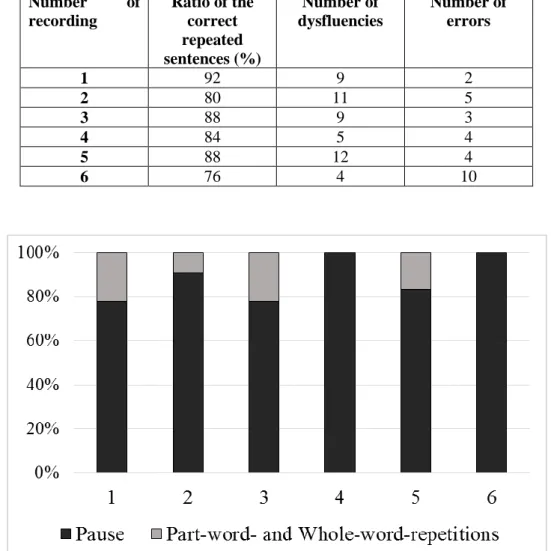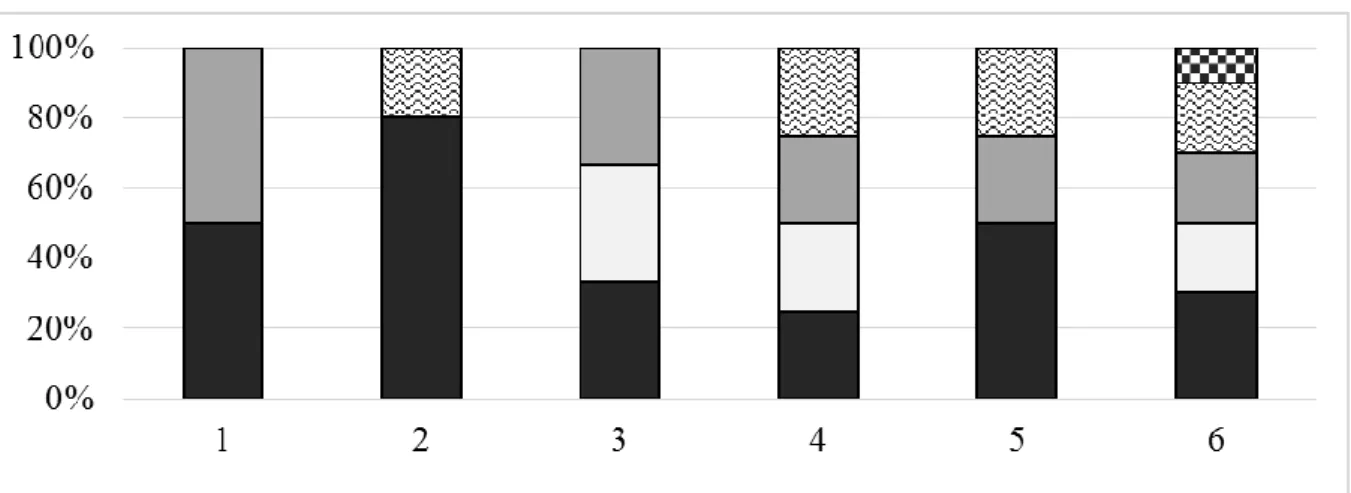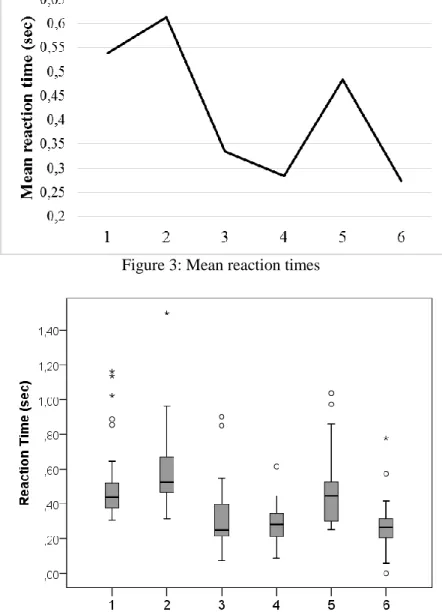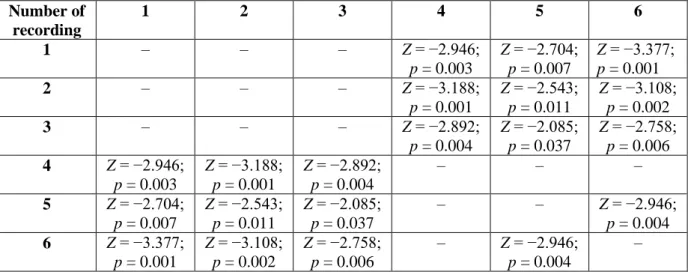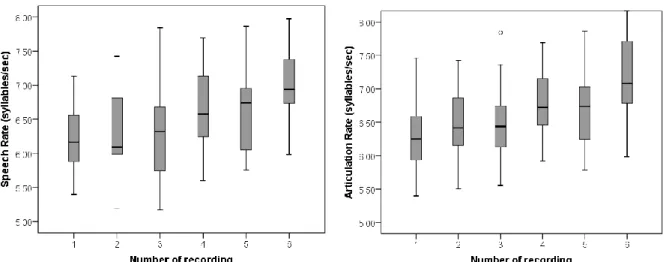1
JUDIT BÓNA
ELTE Eötvös Loránd University, Department of Phonetics Budapest, Hungary bona.judit@btk.elte.hu
Judit Bóna: Characteristics of sentence repetition in young-onset Parkinson’s disease.
A longitudinal case study
Alkalmazott Nyelvtudomány, XVIII. évfolyam, 2018/1. szám doi:http://dx.doi.org/10.18460/ANY.2018.1.001
Characteristics of sentence repetition in young-onset Parkinson’s disease. A longitudinal case study
A Parkinson-kór (PD) egy progresszív lefolyású degeneratív központi idegrendszeri betegség, amely az agy bizonyos részein kialakuló dopaminhiánnyal áll összefüggésben. A Parkinson-kórt általában időskori betegségnek tartják, de előfordulhat fiatalkorban is. A jelen tanulmány azt mutatja be, hogy hogyan változott egy fiatalkori Parkinson-kórral élő férfi mondatismétléses tesztben mutatott teljesítménye négy és fél éven keresztül, a pontos diagnózis felállítása előtti időtől kezdve az agyműtétet követő egy hónapig. A beteg a vizsgálat kezdetekor 33 éves, az utolsó felvétel idején 38 éves volt. A mondatismétléses teszt évente egyszer került rögzítésre, illetve az utolsó felvétel rövidebb időintervallumon, öt hónapon belül készült az utolsó előtti felvételhez képest. Az elemzés a következőkre irányult: az ismétlések pontossága, a beszéd folyamatossága, a reakcióidők, illetve a beszéd- és artikulációs tempó. Az eredmények azt mutatják, hogy a beteg állapota nagymértékben befolyásolta az elemzett paramétereket, ugyanakkor a beszédtempóra nem volt hatással. Véleményem szerint a fiatalkori Parkinson-kór beszédjellemzőinek tanulmányozása hozzájárulhat a betegség pontosabb megismeréséhez.
Introduction
Parkinson’s disease (PD) is a progressive neurological disease which is caused by the lack of dopamine in certain parts of the brain. It’s main symptoms are rigidity, rest tremor, bradykinesia (slowness of movement), akinesia (the inability of initiating a movement) (Brodal 1998; Kempler–Lancker 2002).
PD is generally considered disease of the elderly, but in rare cases it can begin in young age. PD beginning between 21 and 39 is called young-onset Parkinson’s disease, and PD beginning before 20 is called juvenile Parkinson’s disease (Calne–Kumar 2008). These types occur very rarely. There is only a little literature about young-onset PD. What we know is that course of the disease is less severe but longer than in the elderly (Golbe 1991; Schrag et al.
1998; Calne–Kumar 2008). In case of young-onset PD generally there are no additional diseases. However, these patients have to face with quite a few lifestyles challenges (starting a family, raising children, working etc.) which might cause psychological difficulties. In addition, in case of elderly patients of PD aging has an effect on the symptoms, too. Whereas in case of young patients with PD the age factor doesn’t influence the symptoms, so the effects of the disease can be examined on their own. For this reason, it would be important to
2
get to know the characteristics of young-onset PD and the speech of these speakers, among others.
PD might often cause speech deficits, which are called hypokinetic dysarthria.
Its symptoms in speech can be the followings: inaccurate articulation, monotonous speech, irregular voice quality, monoloudness, reduced stress, inappropriate and/or long pauses, frequent disfluent repetitions and changes in articulation rate (Ackermann–Ziegler 1991; Kempler–Lancker 2002;
Goberman–Blomgren–Metzger 2010). There are contradictory findings about the disturbance of speech rate in the literature. Some authors found that there are no significant differences between speakers with PD and healthy speakers in articulation rate (De Letter et al. 2006; Skodda–Schlegel 2008). Others found some speakers with PD who spoke with faster speech rate, while there are data from speakers who spoke more slowly than controls (Adams 1994; Martínez- Sánchez et al. 2014; Hsu et al. 2017). Intelligibility of PD is highly influenced by the speech task. Kempler & Lancker (2002) found that the speech of a 74- year-old man with PD was the less intelligible during spontaneous speech (only in 29%). The intelligibility was 78% during reading, and 88% during spontaneous singing.
Comparing the speech characteristics of young-onset and late-onset PD, Messinis et al. (2001) found that the following symptoms are less frequent in young-onset PD than in late-onset PD: breathy voicing, hypernasality, reduction of intelligibility. However, the following symptoms are more typical features in young-onset PD than late-onset PD: imprecise articulation, monotonous speech, and rhythm disturbances (Messinis et al. 2001). This latter is a consequence of the changes in articulation rate and its higher variability.
These findings are based on clinical observations. However, there are very few studies about symptoms of speech in young-onset PD, the method of which would be objective phonetic analysis.
The aim of this paper is to present the characteristics of sentence repetition ability in young-onset Parkinson’s disease through a longitudinal case study.
The analysis applies to several levels of speech. Correctness of repetitions, fluency, reaction time and durational and rate characteristics will be analysed.
The sentence repetition task has several advantages. On the one hand, it shows the capacity of working memory and some aspects of the grammatical processing (e.g. Potter & Lombardi, 1998; Small et al. 2000). It is important because PD patients appear to have difficulty comprehending sentences (Colman et al. 2011). On the other hand, for the longitudinal study this is one of the best methods to record controlled language material. Sentence repetitions of elderly speakers with PD were analysed in various experiments (Berg et al.
2003; Lewis et al. 1998; Troche & Altmann 2012). Berg et al. (2003) and Lewis et al. (1998) found that there is no significant difference between healthy speakers and speakers with PD in the correctness of sentence repetitions. Troche and Altmann (2012) found that elderly speakers with PD performed more poorly
3
than healthy speakers, especially in fluency. However, when cognitive ability was controlled, there was no significant difference between the two groups.
The main questions of this paper are the following: 1) Are there any changes in the correctness of sentence repetitions in the different phases of the disease?
2) How do the characteristics of tempo change during the years?
According to the hypotheses, 1) correctness and fluency of the repetitions will be influenced by the state of the participant (in this study, ‘state of the participant’ means phase of the development of the disease over time); 2) the reaction times will be shorter when the participant was better compared to other times; 3) speech rate and articulation rate will also show the state of the participant: the speech rate of the samples recorded in better state will be slower.
Procedure The participant
One speaker with young-onset PD participated in the study. He (BA) was 33- year-old at the first examination, and 38-year-old at the end of the analysis. The first symptoms of his disease appeared at 28 years of age. At that time, the disease could not be diagnosed from the symptoms. The first diagnosis was reached almost six years later than the first symptoms appeared. After that more years were needed to exclude the possibilities of other diseases.
BA has a university degree. He lived an active life, he played sports a lot even after the diagnosis of the PD. He stopped only right before the brain surgery.
At the time of the first recording, his drug treatment was in experimental phase. It was being searched which drugs would be the most effective for him.
At the 2nd recording, he took medicines with three effective agents: levodopa, carbidopa, and entacapone. At the time of the 3rd and 4th recordings, his state showed significant improvement thanks to the medical treatments, although it was fluctuating as he described it. The symptoms were influenced by the weather, tiredness and psychological state etc. The symptoms were fluctuating within a period of months, days and even hours. At the time of the penultimate recording, the patient started to get prepared for the brain surgery. There had been extensive fluctuations despite the fact that he was taking levodopa, carbidopa, entacapone, and dopamine-antigonist. These fluctuations justified the need for the brain surgery. The very last recording was made one month after the surgery, before switching on the brain implant.
Table 1 shows the patient’s (BA) state and medication at the different recordings.
4
Table 1: The patient’s (BA) state at the recordings Number of
recording
Treatment The patient’s state
1. Medication with effective agent:
selegiline and ropinirole
No exact diagnosis yet. Medication in experimental/trial phase. Rapid loss of effect of medication. Fast and monotonous speech.
2. Medication with effective agent:
levodopa/carbidopa/entacapone added to the previous medication
Diagnosis of PD. Exclusion of other diseases.
Promising improvements for levodopa. Fast and monotonous speech.
3. Medication: in accordance with the previous ones.
Improves state, according to own judgement.
Extensive motoric fluctuation. Fast and monotonous speech.
4. Medication: in accordance with the previous ones.
Extensive motoric fluctuation. Fast and monotonous speech.
5. Medication: in accordance with the previous ones.
Extensive fluctuation. Sudden freezing.
Difficulty in precision movements.
Psychological symptoms. Sleeping disorders (couldn’t sleep for longer than 3 hours at night).
Fast and monotonous speech.
6. One month after the brain surgery. The implanted system hasn’t been activated yet.
Significantly reduced hypokinesis and rigidity, as a result of microlesion. Fast and monotonous speech.
Material
Except for the very last recording, every recording was made at the same time, in the same place and with the same recorder (ZOOM H4). That means that recordings were made in January, every year, in a soundproof chamber. The time between different recordings was one year except between the 5th and 6th occasions where only five months passed. This was the period when the participant was prepared for the brain surgery and when the brain surgery happened. Recordings were made late in the afternoon before the evening medication. The participant arrived to the place of the recordings after work.
The last recording was made at the home of the participant in a quiet room, exactly four weeks after the operation. This was the period of recuperation after the surgery. The participant was at home, but he performed some distance-work for his workplace.
The task was the repetition of 25 sentences one-by-one right after they were said by the experimenter. The sentences were the same as in the sentence repetition task of the Hungarian Spontaneous Speech Database called BEA (Gósy 2012). The length, syntactic complexity and vocabulary of the sentences were various. The length was 15-26 syllables which means 5-11 words (the average working memory size of Hungarian adults is 24-25 syllables, Gósy 2005). Among the words of the sentences there were rare words like űrturista
‘space tourist’, tulipánágyások ‘tulip beds’, gyöngyhalászok ‘pearl-divers’ etc.
Twenty sentences were simple, five sentences were complex (coordinate and subordinate sentences). Examples for simple sentences: Az ügyfeleknek kompromisszumot kellett kötniük. ‘The clients had to make a compromise.’ A
5
kalauz szigorúan ellenőrzi a menetjegyeket és az igazolványokat. ‘The ticket inspector checks the tickets and ID-cards quite strictly.’ Examples for complex sentences: Nem lehetett megjósolni, mikorra várható a vulkánkitörés. ‘It couldn’t have been forecast when to expect the volcano eruption.’ Nem kötött biztosítást, ezért kisebb vagyonba került a kórházi ellátás. ‘He hadn’t got an insurance, that’s why the hospital stay cost him a small fortune.’
Methods
The ratio of correct repetitions was defined. Errors in false repetitions were analysed, too. Every repetition was considered correct in which the words were the same as in the original sentence independently of hesitations and long silent pauses. The frequency of silent and filled pauses, part-word repetitions and whole-word repetitions was analysed, as well.
Recordings were annotated by Praat 5.0. Reaction times (the time between the end of the last sound of the sentence to be repeated and the first sound of the participant’s repetition), durations of the participant’s sentences, and durations of pauses in the repeated sentences were measured. After that, speech rate and articulation rate were calculated for each sentence.
Relations between the length and grammatical complexity of the sentences and the correctness and reaction time of repetitions were analysed, too.
Results of the speech samples recorded in different occasions were compared.
The relation between these present results and the results of a study conducted on healthy young Hungarian speakers (Bóna 2011) was analysed. In that previous study the very same sentences had to be repeated.
Statistical analyses (Friedman Test, Wilcoxon Signed Ranks Test, Pearson correlation, repeated measures ANOVA) were carried out at 95% confidence level by SPSS 20.
Results
Accuracy of sentence repetition
Table 2 shows the ratio of the correct repetitions, the number of hesitations and pauses, and the number of errors. While the number of the repeated sentences was the same at every occasion, and there could occur more disfluencies in the same sentence, the number of disfluencies and errors are presented instead of the ratios. The participant produced the most correct repetitions (23 correct sentences) at the first occasion. The least correct answers (19 correct sentences) were given at the last occasion (after the brain surgery). In this recording errors occurred in the highest number, too. However, disfluencies and silent pauses occurred the least frequently at the last occasion. There was a great difference between the very last and the penultimate occasion in the frequency of disfluencies. Bóna (2011) found that healthy young people of the same age produced 23-25 correct repetitions of the same sentences.
6
The most frequent type of disfluency phenomena was silent pause. In addition, part-word and whole-word repetitions occurred in the speech samples (Figure 1). Errors could be categorized in five types which are the following: 1) addition (during repetition, one or more sounds, syllables or words are added to the original sentence), 2) deletion (one or more elements are left out from the sentence), 3) substitution (one element is replaced by another element), 4) structural change (the structure of the sentence is modified), and 5) repetition after second hearing. The most frequent error was addition, the less frequent (only one occurrence) was repetition after second hearing (Figure 2).
Table 2: Indicators of accuracy of sentence repetition Number of
recording
Ratio of the correct repeated sentences (%)
Number of dysfluencies
Number of errors
1 92 9 2
2 80 11 5
3 88 9 3
4 84 5 4
5 88 12 4
6 76 4 10
Figure 1: Ratio of pauses and repetitions
7
Figure 2: Ratio of error types
There were five sentences repetition of which were correct in every occasion.
These sentences were simple and affermative, for example: A gyöngyhalászok hosszú ideig képesek a víz alatt maradni. ’Peral-divers are able to stay under water for a long time.’ A hegyimentőknek sűrű köddel kellett megküzdeniük.
’The mountain rescue team had to fight some quite thick fog.’ There were six sentences repetition of which prooved difficult for the patient at four occasions.
He produced errors and/or disfluencies in them. For example: A tegnap esti repülőszerencsétlenséget senki nem élte túl. ’Nobody survived last night’s plane- crash.’ Még nem lehet tudni milyen súlyos a buszbaleset sérültjeinek állapota.
’At this moment we can’t confirm anything about the state of the casualties of the bus-crash.’
There was moderate positive significant correlation between the number of syllables of sentences and the number of correct sentences: r = 0.585; p = 0.002.
This means that the longer the sentence was, the more likely there was problem in the sentence repetition. In Bóna (2011), there was no significant correlation between the correctness of helathy young adults’ repetitons and the number of syllables of the sentences. Significant correlation between these data was only in the case of young-old and old-old speakers.
Reaction times
The shortest mean reaction time (237 ms) was measured at the very last occasion. The longest mean reaction time (613 ms) was measured at the second occasion (Figure 3). Bóna (2011) found that the mean reaction time of young healthy speakers was 457 ms. In the present analysis, the distribution of the reaction times was large during every recording (Figure 4).
There was only one case when the reaction time was 0 ms. This occurred during the very last recording, at the repetition of the very first sentence (which was: A nagymama specialitása kétséget kizáróan a barackbefőtt. ‘The speciality of grandma was undoubtedly apricot preserve.’). This sentence had the shortest
8
reaction time at each occasion. The longest reaction time (1162 ms) was measured during the very first recording by the following sentence: Nem lehet eléggé hangsúlyozni a túlzásba vitt napozás veszélyét. ‘The danger of excessive sunbathing cannot be emphasized enough.’ Considering every occasion, the longest reaction time was measured by the following sentence: Nem lehet egyértelműen kijelenteni, hogy kinek volt igaza. ‘It can’t be expressly declared who was right.’ In this complex sentence, the negation and the two tenses might cause the problem.
According to the Friedman Test, there was significant difference between the reaction times recorded in different occasions: χ2 = 64.794; p < 0,001.
According to the Wilcoxon Signed Ranks Test, there was no significant difference between the different occasions only in some cases (Table 3).
There was no significant correlation between the number of syllables and reaction times in any of the recordings.
Figure 3: Mean reaction times
Figure 4: Distribution of reaction times
9
Table 3: Results of the statistical analyses (significant differences between the speech samples recorded at different times in reaction times)
Number of recording
1 2 3 4 5 6
1 – – Z = −3.215;
p = 0.001
Z = −3.700;
p < 0.001
– Z = −4.130;
p < 0.001
2 – – Z = −4.130;
p < 0.001
Z = −4.211;
p < 0.001
Z = −2.085;
p = 0.037
Z = −4.372;
p < 0.001 3 Z = −3.215;
p = 0.001
Z = −4.130;
p < 0.001
– – Z = −2.785;
p = 0.005
–
4 Z = −3.700;
p < 0.001
Z = −4.211;
p < 0.001
– – Z = −3.538;
p < 0.001
–
5 – Z = −2.085;
p = 0.037
Z = −2.785;
p = 0.005
Z = −3.538;
p < 0.001
– Z = −3.700;
p < 0.001 6 Z = −4.130;
p < 0.001
Z = −4.372;
p < 0.001
– – Z = −3.700;
p < 0.001
–
Temporal characteristics
Mean duration of the repeated sentences become shorter and shorter during the years (except the 5th occasion). The shortest mean duration (3142 ms) was measured at the last recording. The longest mean duration of the repeated sentences (3530 ms) was measured at the 5th recording. According to the Friedman Test, there was significant difference between the different recordings in the duration of sentences: χ2 = 55.971; p < 0.001. According to the Wilcoxon Signed Ranks Test, there were no significant differences between the first three occasions, and between the 4th and 5th occasions in sentence duration (Table 4).
There was moderate or strong positive significant correlation between the number of syllables and the duration of the sentences (1st occasion: r = 0.889; p
< 0.001; 2nd occasion: r = 0.740; p < 0.001; 3rd occasion: r = 0.569; p = 0.003;
4th occasion: r = 0.781; p < 0.001; 5th occasion: r = 0.539; p = 0.005; 6th occasion: r = 0.696; p < 0.001).
Figure 5: Mean sentence durations
10
Table 4: Results of the statistical analyses (significant differences between the speech samples recorded at different times in sentence durations)
Number of recording
1 2 3 4 5 6
1 – – – Z = −2.946;
p = 0.003
Z = −2.704;
p = 0.007
Z = −3.377;
p = 0.001
2 – – – Z = −3.188;
p = 0.001
Z = −2.543;
p = 0.011
Z = −3.108;
p = 0.002
3 – – – Z = −2.892;
p = 0.004
Z = −2.085;
p = 0.037
Z = −2.758;
p = 0.006 4 Z = −2.946;
p = 0.003
Z = −3.188;
p = 0.001
Z = −2.892;
p = 0.004
– – –
5 Z = −2.704;
p = 0.007
Z = −2.543;
p = 0.011
Z = −2.085;
p = 0.037
– – Z = −2.946;
p = 0.004 6 Z = −3.377;
p = 0.001
Z = −3.108;
p = 0.002
Z = −2.758;
p = 0.006
– Z = −2.946;
p = 0.004
–
Speech rate and articulation rate was getting faster during the years. Only the 5th recording was an exception, when the speech rate and articulation rate slightly decreased (Table 5). At every occasion, both values were faster than the speech rate and articulation rate of Hungarian healthy young adults. Their speech rate in narratives was 4.3 syllables/sec (SD: 0.6), their articulation rate was 5.8 syllables/sec (SD: 0.6) (Bóna 2014). (There isn’t any available data about the speech and articulation rate in sentence repetition.) The distribution of the speech rate and articulation rate calculated for each sentences was large at every occasion (Figure 6). According to the repeated measures ANOVA, there were significant differences between the different recordings in speech rate [F(5, 120) = 15.312; p < 0.001; η2 = 0.390] and articulation rate [F(5, 120) = 38.478;
p < 0.001; η2 = 0.616]. However, Pairwise Comparisons show significant differences especially between the very last and the previous occasions (see the results of the statistical analyses in Table 6).
Table 5: Mean values of speech rate and articulation rate
Number of
recording
Speech rate (syllables/s)
Articulation rate (syllables/s)
1 6.22 6.30
2 6.31 6.47
3 6.32 6.47
4 6.66 6.80
5 6.55 6.70
6 7.03 7.14
11
Figure 6: Speech rate and articulation rate
Table 6: Results of the statistical analyses (significant differences between the speech samples recorded at different times in speech rate and articulation rate)
Number of recording
1 2 3 4 5 6
Speech Rate
1 – – – p = 0.002 – p < 0.001
2 – – – – – p < 0.001
3 – – – p = 0.037 – p < 0.001
4 p = 0.002 – p = 0.037 – – –
5 – – – – p = 0.009
6 p < 0.001 p < 0.001 p < 0.001 – p = 0.009 –
Articulation Rate
1 – – – p < 0.001 p = 0.001 p < 0.001
2 – – – p < 0.001 – p < 0.001
3 – – – p < 0.001 p = 0.030 p < 0.001
4 p < 0.001 p < 0.001 p < 0.001 – – p = 0.001
5 p = 0.001 – p = 0.030 – – p = 0.001
6 p < 0.001 p < 0.001 p < 0.001 p = 0.001 p = 0.001 –
The fastest tempo was measured at the same sentence at four occasions. It was pronounced with a mean speech rate of 7.58 syllables/sec. This sentence was the following: A kalauz szigorúan ellenőrzi a menetjegyeket és az igazolványokat.
‘The ticket inspector checks the tickets and ID-cards quite strictly.’ The slowest tempo was measured at the same sentence at two occasions. It was pronounced with a mean speech rate of 5.69 syllables/sec. This sentence was the following:
A farsangi bálban mindenkinek szép jelmeze volt. ‘Everyone was wearing a beautiful costume in the carnival.’
Conclusions
In this longitudinal study, characteristics of sentence repetitions of a speaker with young-onset PD were analysed. The aim of the paper was to present how speech changes in the different stages of the disease. It was an unexpected result that the ratio of the correct repetitions decreased compared to the result of the
12
first recording, and the lowest ratio was after the brain surgery. Except for the first occasion, the patient’s results were below the healthy speakers’. However, the occurrence of disfluencies was the least frequent at the last recording, so after the brain surgery the speech became more fluent. Previous studies proved that the appropriate medication and the appropriate dopamine-level reduce the frequency of disfluencies in PD (Goberman & Blomgren 2003; Goberman et al.
2010). In this case, BA wasn’t given any medication, but the effect of microlesion after the brain surgery improved the fluency of speech. Comparing the ratio of correct repetitions with the temporal data, the explanation of the ratio of incorrect repetitions may be the shorter reaction time and faster speech rate.
In addition, this was the period of recuperation after the surgery, so the patient might have been more tired or inattentive than at the earlier occasions. (The first hypothesis was confirmed.)
Reaction times highly depended on the patient’s state. Reaction times were longer when his state was more severe (the second hypothesis was confirmed).
In these cases reaction times were longer than healthy young adults’, too. When the patient’s state was better, reaction times decreased. The shortest mean reaction time was measured at the very last recording. At this occasion, the mean reaction time was almost half than the mean reaction time measured in healthy young adults.
At every occasion, the patient’s speech rate and articulation rate were faster than healthy young adults’. With the progressing of the disease, speech rate and articulation rate were getting faster independently of the patient’s state (the third hypothesis wasn’t confirmed). The control of speech tempo doesn’t seem to be influenced by treatment. Results show that reaction times and tempo values are independent from each other.
In this study, sentence repetition of a single speaker with young-onset PD was analysed, so the results cannot be generalized. However, the analysis of young- onset PD is important even in the form of case studies, because it can contribute to the more precise understanding of PD. As young-onset PD is very rare and difficult to diagnose, it is worth examining whether the change of speech can help to establish a prior diagnosis.
SUPPORTED THROUGH THE NEW NATIONAL EXCELLENCE PROGRAM OF THE MINISTRY OF
HUMAN CAPACITIES.
References
Ackermann, H. and Ziegler, W. (1991) Articulatory deficits in parkinsonian dysarthria: an acoustic analysis. Journal of Neurology, Neurosurgery & Psychiatry, 54(12), 1093-1098.
Adams, G. G. (1994) Accelerating speech in a case of hypokinetic dysarthria: descriptions and treatment. In J. S. Till, D. R. Beukelman, K. M. Yorkston (Eds.), Motor speech disorders:
Advances in assessment and treatment (pp. 213–228). Baltimore: Brookes.
13
Berg, E., Björnram, C., Hartelius, L., Laakso, K., Johnels, B. O. (2003) High-level language difficulties in Parkinson's disease. Clinical Linguistics & Phonetics, 17(1), 63–80.
Bóna, J. (2011) A mondatismétlés sajátosságai fiatal, idősödő és idős korban. [The characteristics of sentence repetition in young, young-old and old-old speakers] In Navracsics, J.–Szabó, D. (eds.): A mentális folyamatok a nyelvi feldolgozásban. Pszicholingvisztikai tanulmányok III. Budapest: Tinta Könyvkiadó. 181–189.
Bóna, J. (2014) Temporal characteristics of speech: the effect of age and speech style. The Journal of the Acoustical Society of America, 136(2), EL116-EL121.
Brodal, P. (1998) The central nervous system: structure and function (2nd ed.). New York: Oxford University Press.
Calne, S. M. and Kumar, A. (2008) Young onset Parkinson's disease. Practical management of medical issues. Parkinsonism & related disorders, 14(2), 133–142.
Colman, K. S., Koerts, J., Stowe, L. A., Leenders, K. L., Bastiaanse, R. (2011) Sentence comprehension and its association with executive functions in patients with Parkinson's disease.
Parkinson’s disease, 2011.
http://downloads.hindawi.com/journals/pd/2011/213983.pdf
Goberman, A. M., & Blomgren, M. (2003) Parkinsonian speech disfluencies: effects of L-dopa- related fluctuations. Journal of fluency disorders, 28(1), 55–70.
Goberman, A. M., Blomgren, M., & Metzger, E. (2010) Characteristics of speech disfluency in Parkinson disease. Journal of Neurolinguistics, 23(5), 470–478.
Golbe, L. I. (1991) Young‐onset Parkinson's disease A clinical review. Neurology, 41(2 Part 1), 168–
168.
Gósy, M. (2005) Pszicholingvisztika. [Psycholinguistics.] Budapest: Osiris Kiadó.
Gósy, M. (2012) BEA – A multifunctional Hungarian spoken language database. Phonetician 105–
106, 50–61. http://www.isphs.org/Phonetician/Phonetician_105_106.pdf
Kempler, D. and Van Lancker, D. (2002) Effect of speech task on intelligibility in dysarthria: A case study of Parkinson's disease. Brain and language, 80(3), 449–464.
Lewis, F. M., Lapointe, L. L., Murdoch, B. E., Chenery, H. J. (1998) Language impairment in Parkinson's disease. Aphasiology, 12(3), 193–206.
De Letter, M., Santens, P., De Bodt, M., Boon, P., Van Borsel, J. (2006) Levodopa-induced alterations in speech rate in advanced Parkinson's disease. Acta Neurologica Belgica, 106(1), 19.
Hsu, S. C., Jiao, Y., McAuliffe, M. J., Berisha, V., Wu, R. M., Levy, E. S. (2017) Acoustic and perceptual speech characteristics of native Mandarin speakers with Parkinson's disease. The Journal of the Acoustical Society of America, 141(3), EL293-EL299.
Martínez-Sánchez, F., Meilán, J. J. G., Carro, J., Íñiguez, C. G., Millian-Morell, L., Valverde, I.
P., López-Alburquerque, T., López, D. E. (2016) Speech rate in Parkinson's disease: a controlled study. Neurología (English Edition), 31(7), 466–472.
Messinis, L., Antoniadis, G. P., Biris, A. (2001) Clinical Symptomatology and Speech impairments
in Youth-onset Parkinson’s Disease (YOPD) patients.
http://psychology.gr.tripod.com/articles/youth_onset_parkinson_s_disease_en_ft.pdf (29 September of 2017)
Potter, M. C. and Lombardi, L. (1998) Syntactic priming in immediate recall of sentences. Journal of Memory and Language, 38, 265–282.
Skodda, S. and Schlegel, U. (2008) Speech rate and rhythm in Parkinson's disease. Movement Disorders, 23(7), 985–992.
Schrag, A., Ben‐Shlomo, Y., Brown, R., David Marsden, C., Quinn, N. (1998) Young‐onset Parkinson's disease revisited—clinical features, natural history, and mortality. Movement Disorders, 13(6), 885–894.
Skodda, S. and Schlegel, U. (2008) Speech rate and rhythm in Parkinson's disease. Movement Disorders, 23(7), 985–992.
Small, J. A., Kemper, S., Lyons, K. (2000) Sentence repetition and processing resources in Alzheimer's disease. Brain and Language, 75(2), 232–258.
Troche, M. S. and Altmann, L. J. (2012) Sentence production in Parkinson disease: Effects of conceptual and task complexity. Applied Psycholinguistics, 33(2), 225–251.
